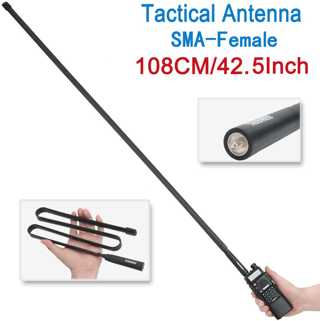To directly answer your question, the ideal antenna length for maximum radiation is dependent on the wavelength.
For example, CB wavelength is approximately 11m. The ideal antenna is half of that for a dipole antenna. However, most CB (and HT) antennas are monopoles, which split the antenna in half and use its mount as the other half, so the ideal CB antenna would be approximately 2.75m, or just under 9 ft, using the vehicle body as the other half of the antenna. (A vehicle with less than 9ft of metal may not work well with such an antenna.)
Similarly, the ideal 2m antenna for an HT would be approximately 0.5m with you holding the radio for the other half of the antenna, although you can also get a 1m antenna ("half wave") that will work somewhat better, as this is an end fed dipole instead of a monopole, and doesn't rely on you holding the radio to make the other half of the antenna.
If the antenna is a full 1/4 wavelength, it is typically not a coil. Shorter antennas probably are, but the length of the wire in the coil changes as the antenna gets physically shorter, so it is not direct relationship, but electrically, it will still measure as 1/4 or 1/2 wavelength.
The higher frequencies like 2m and 70cm are very dependent on line of sight between the receiver and transmitter, and thus height of the antenna is a huge factor in antenna effectiveness. Thus, the size of the antenna may increase effectiveness not because of better radiation, but because of better height, and you might get the same effect with a smaller antenna raised higher. This is one of the advantages of external antennas like the J-pole -- you can separate it from the radio with coax and raise it higher. (The j-pole is also an end fed dipole. )
Lastly, when considering the "optimal" antenna, you need to take mechanical factors into consideration. In other words, larger HT antennas are heavier and can become a huge lever arm, and put more stress on the radio's antenna connector, and have a higher chance of breaking it. Half wave antennas typically also include an impedance matching coil, which makes them even heavier. When using large antennas, some care must be taken to minimize stress on the radio's antenna connector.
It is possible to get a "better" antenna that is longer than 1/2 wavelength, but it would no longer be a dipole. For instance, a colinear antenna is a stacked phased array of dipoles and can be many multiples of 1/4 wavenlength. This describes some larger wifi antennas and possibly some vehicle antennas or antennas mounted to buildings, but you won't find a 70cm HT colinear, its just too big.
